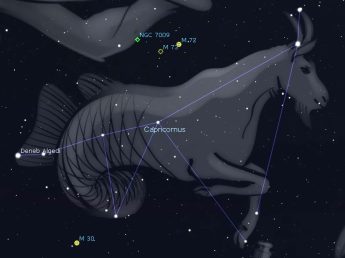This Week’s Sky at a Glance, 2025 Aug 30 – Sept 6
This Week’s Sky at a Glance, 2025 Aug 30 – Sept 6
The constellation Capricornus is a large chevron shape that is south-southeast around 10 pm this week. A pair of stars marks each upper corner, and both stars of the western pair are colourful wide double stars. The sea goat arises from a tale of the Olympian gods being surprised by Typhon, the most ferocious of the rival Titans. Knowing Typhon was not fond of water, the gods changed into fish and escaped to the sea. The god Pan, who was half-goat and half-man, panicked and dove in before the transformation was complete and wound up with a goat’s head and the tail of a fish.
There are four common targets for backyard telescope users near Capricornus, but only the globular cluster M30 off the east side of the chevron is officially within its borders. It is also the easiest of the targets for binoculars. The globular cluster M72 and the four-star (literally four stars, it is not an observing highlight) asterism M73 are above in Aquarius. Nearby is the more challenging, but worth the effort, Saturn Nebula (NGC7009), the gaseous remnant of a dead star that somewhat resembles the ringed planet.
A few millennia ago the Sun was in Capricornus at the winter solstice, when at midday it was overhead at latitude -23.5 degrees. This is the southern border of the tropics, and it is still called the Tropic of Capricorn despite the Sun being in Sagittarius at this time. Earth’s 25,800 year polar wobble, called the precession of the equinoxes, is responsible for this shift.
This Week in the Solar System
Saturday’s sunrise in Moncton is at 6:37 and sunset will occur at 8:00, giving 13 hours, 23 minutes of daylight (6:43 and 8:04 in Saint John). Next Saturday the Sun will rise at 6:46 and set at 7:47, giving 13 hours, 1 minute of daylight (6:52 and 7:51 in Saint John).
The Moon is at first quarter near Antares this Sunday, and it maintains a low altitude all week as it orbits near its maximum distance below the ecliptic (a major lunar standstill). Mercury rises an hour before sunrise this weekend, but by next weekend the gap shortens to half an hour. Venus slides to the right of the Beehive cluster in Cancer this Sunday and Monday, a possible binocular treat around 5 am. Jupiter is prominent in the early morning sky among the stars of Gemini. Telescope users under high magnification might see the shadow of Saturn’s moon Titan crossing the planet early Thursday morning, starting at 2:25 and reaching halfway at 4:09. Over the next two weeks Mars will be making a ten-degree run toward Spica, low in the west in evening twilight.
The Saint John Astronomy Club meets in the Rockwood Park Interpretation Centre on September 6 at 7 pm.

